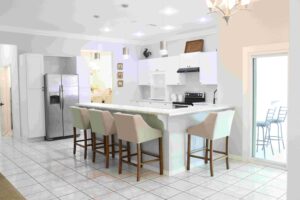Well, I know how hard it can be to get the most of what little space there is when you’ve been living in a variety of tiny apartments for years. The ability to come up with creative ways of dealing with lighting is something that I’ve found extremely useful. Besides helping to make a room seem bigger, the proper lighting can also produce an impression of personality and warmth. I’ll give you some of the best advice on how to maximize your little space with innovative lighting solutions in this article.
· Use Mirrors to Reflect Light
One of the easiest ways to make a small space feel bigger is to use mirrors strategically. Not only do they reflect light, but they also create the illusion of depth. One great way to incorporate mirrors into your lighting plan is to position them across from windows or other sources of natural light. This will help to amplify the amount of light in the room, making it feel brighter and more spacious.

· Get Creative with Lighting Fixtures
While you may not have the luxury of ample square footage, you can still get creative with lighting fixtures to add visual interest and personality to your space. Consider incorporating statement pieces like a chandelier or pendant light, or using wall sconces to highlight artwork or architectural details. If you’re working with a particularly low ceiling, consider flush mount lighting options that won’t take up too much vertical space.
· Invest in Dimmer Switches
Having control over your lighting is one of the secrets to making a tiny area seem warm and inviting. You may change the brightness of your lighting to match your mood or the time of day by investing in dimmer switches. This can emphasize particular aspects of your space and contribute to the creation of a cozy and friendly atmosphere.
· Use Task Lighting to Define Zones
It can be difficult to set up distinctive zones for individual activities when you’re working in a small space. One way to achieve this is to use task lighting to define specific areas. For example, you might use a pendant light above your dining table, or a floor lamp next to your reading nook. This can help to create a sense of purpose and organization, even in a compact space.
· Play with Color Temperature
Another way to add depth and interest to your lighting plan is to play with color temperature. Warm light (around 2700K) can create a cozy and intimate atmosphere, while cool light (around 4000K) can feel more energizing and invigorating. Consider incorporating both warm and cool light sources throughout your space to create a dynamic and layered effect.
· Incorporate Natural Light
Even if your small space doesn’t have many windows, there are still ways to incorporate this valuable resource. Consider hanging sheer curtains that allow light to filter through, or adding reflective surfaces like glass or metal to bounce light around the room. If you’re feeling adventurous, you might even consider installing a skylight or solar tube to bring in even more natural light.
· Use Wall Washers to Add Depth
Wall washers are lighting fixtures that are designed to “wash” a wall with light. They can be used to create a sense of depth and texture in a small space by highlighting the texture of your walls. This can be especially effective in a space with an exposed brick or stone wall, or in a room with an accent wall.
· Highlight Your Artwork
If you have artwork or decorative items that you want to showcase, consider using accent lighting to draw attention to them. This could include installing a picture light above a painting, or using a small spotlight to highlight a sculpture or other decorative item. This can help to create a focal point in your space and add visual interest.
· Layer Your Lighting
To create a truly dynamic lighting plan, consider layering your lighting. This means using a variety of different fixtures and light sources to create different levels of light in your space. For example, you might use recessed lighting to provide overall ambient light, pendant lights to create task lighting, and table lamps to add a cozy glow. In this way, you might be able to make your room more visually interesting and manage its mood.
· Consider Under-Cabinet Lighting
Under-cabinet lighting may make all the difference in a little bathroom or kitchen. Your countertops will appear brighter, and it will be simpler to see what you are doing with this kind of illumination. Additionally, especially when used with other forms of lighting, it may provide a cozy and welcoming environment.
· Don’t Forget About Floor Lamps
A tiny area might benefit greatly from the warmth and aesthetic intrigue that floor lamps can bring. You’re guaranteed to discover one that matches your aesthetic because they come in a range of designs and sizes. Consider using a floor lamp in a corner of your living room to create a cozy reading nook, or in your bedroom to add a soft and relaxing glow.
· Use Colorful Lampshades
Consider utilizing vibrant lampshades if you want to give your little area a pop of color. This may be a terrific way to give your lighting fixtures individuality and visual intrigue without taking up a lot of room. Additionally, it’s a quick and inexpensive method to modify your design whenever the whim strikes.
Conclusion
When it comes to maximizing small spaces, every little bit counts. By using innovative lighting techniques, you may design a room that feels bigger, cozier, and more intimate. Whether you’re incorporating statement fixtures, using task lighting to define zones, or playing with color temperature, there are endless possibilities for making the most of limited square footage. So try it, you might be surprised at how much the right light is going to have a difference!
About the Author

-
Welcome to A HomedesignMag! I'm Nancy, a content writer and blog post creator. I share my experience with different homedesign tools and techniques on the blog!
contact us at:
Latest entries
 UncategorizedOctober 15, 2024Timeless Beauty of Mahogany
UncategorizedOctober 15, 2024Timeless Beauty of Mahogany OutdoorsOctober 13, 2024Patio Perfection: 9 Awe-Inspiring Roof Extension Ideas to Add Charm
OutdoorsOctober 13, 2024Patio Perfection: 9 Awe-Inspiring Roof Extension Ideas to Add Charm WindowsAugust 13, 2024Elevating Interiors with Kirsch Sliding Door Blinds
WindowsAugust 13, 2024Elevating Interiors with Kirsch Sliding Door Blinds BathroomAugust 11, 2024Designing Showers with Mosaic Tiles
BathroomAugust 11, 2024Designing Showers with Mosaic Tiles




